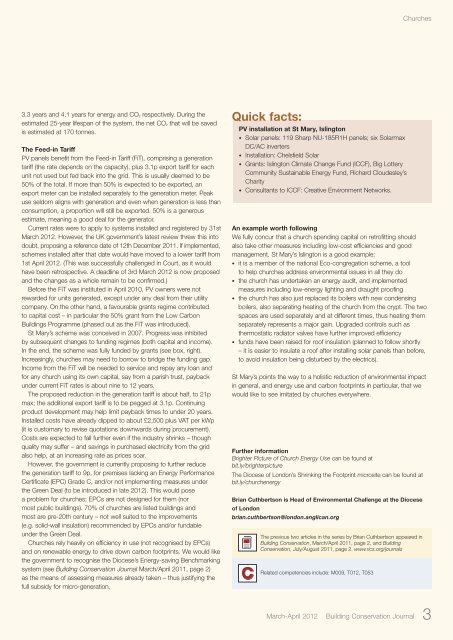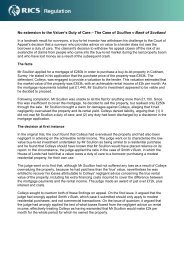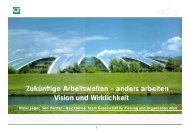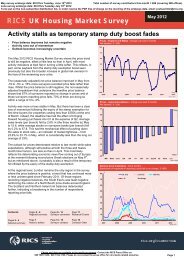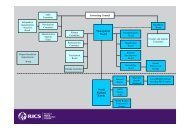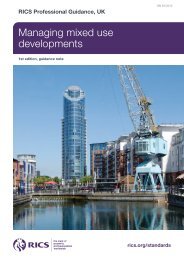Building Conservation Journal - RICS
Building Conservation Journal - RICS
Building Conservation Journal - RICS
Create successful ePaper yourself
Turn your PDF publications into a flip-book with our unique Google optimized e-Paper software.
3.3 years and 4.1 years for energy and CO2 respectively. During the<br />
estimated 25-year lifespan of the system, the net CO2 that will be saved<br />
is estimated at 170 tonnes.<br />
The Feed-in Tariff<br />
PV panels benefit from the Feed-in Tariff (FiT), comprising a generation<br />
tariff (the rate depends on the capacity), plus 3.1p export tariff for each<br />
unit not used but fed back into the grid. This is usually deemed to be<br />
50% of the total. If more than 50% is expected to be exported, an<br />
export meter can be installed separately to the generation meter. Peak<br />
use seldom aligns with generation and even when generation is less than<br />
consumption, a proportion will still be exported. 50% is a generous<br />
estimate, meaning a good deal for the generator.<br />
Current rates were to apply to systems installed and registered by 31st<br />
March 2012. However, the UK government’s latest review threw this into<br />
doubt, proposing a reference date of 12th December 2011. If implemented,<br />
schemes installed after that date would have moved to a lower tariff from<br />
1st April 2012. (This was successfully challenged in Court, as it would<br />
have been retrospective. A deadline of 3rd March 2012 is now proposed<br />
and the changes as a whole remain to be confirmed.)<br />
Before the FiT was instituted in April 2010, PV owners were not<br />
rewarded for units generated, except under any deal from their utility<br />
company. On the other hand, a favourable grants regime contributed<br />
to capital cost – in particular the 50% grant from the Low Carbon<br />
<strong>Building</strong>s Programme (phased out as the FiT was introduced).<br />
St Mary’s scheme was conceived in 2007. Progress was inhibited<br />
by subsequent changes to funding regimes (both capital and income).<br />
In the end, the scheme was fully funded by grants (see box, right).<br />
Increasingly, churches may need to borrow to bridge the funding gap.<br />
Income from the FiT will be needed to service and repay any loan and<br />
for any church using its own capital, say from a parish trust, payback<br />
under current FiT rates is about nine to 12 years.<br />
The proposed reduction in the generation tariff is about half, to 21p<br />
max; the additional export tariff is to be pegged at 3.1p. Continuing<br />
product development may help limit payback times to under 20 years.<br />
Installed costs have already dipped to about £2,500 plus VAT per kWp<br />
(it is customary to revise quotations downwards during procurement).<br />
Costs are expected to fall further even if the industry shrinks – though<br />
quality may suffer – and savings in purchased electricity from the grid<br />
also help, at an increasing rate as prices soar.<br />
However, the government is currently proposing to further reduce<br />
the generation tariff to 9p, for premises lacking an Energy Performance<br />
Certificate (EPC) Grade C, and/or not implementing measures under<br />
the Green Deal (to be introduced in late 2012). This would pose<br />
a problem for churches; EPCs are not designed for them (nor<br />
most public buildings). 70% of churches are listed buildings and<br />
most are pre-20th century – not well suited to the improvements<br />
(e.g. solid-wall insulation) recommended by EPCs and/or fundable<br />
under the Green Deal.<br />
Churches rely heavily on efficiency in use (not recognised by EPCs)<br />
and on renewable energy to drive down carbon footprints. We would like<br />
the government to recognise the Diocese’s Energy-saving Benchmarking<br />
system (see <strong>Building</strong> <strong>Conservation</strong> <strong>Journal</strong> March/April 2011, page 2)<br />
as the means of assessing measures already taken – thus justifying the<br />
full subsidy for micro-generation.<br />
Quick facts:<br />
PV installation at St Mary, Islington<br />
• Solar panels: 119 Sharp NU-185R1H panels; six Solarmax<br />
DC/AC inverters<br />
• Installation: Chelsfield Solar<br />
• Grants: Islington Climate Change Fund (ICCF), Big Lottery<br />
Community Sustainable Energy Fund, Richard Cloudesley’s<br />
Charity<br />
• Consultants to ICCF: Creative Environment Networks.<br />
Churches<br />
An example worth following<br />
We fully concur that a church spending capital on retrofitting should<br />
also take other measures including low-cost efficiencies and good<br />
management. St Mary’s Islington is a good example:<br />
• it is a member of the national Eco-congregation scheme, a tool<br />
to help churches address environmental issues in all they do<br />
• the church has undertaken an energy audit, and implemented<br />
measures including low-energy lighting and draught proofing<br />
• the church has also just replaced its boilers with new condensing<br />
boilers, also separating heating of the church from the crypt. The two<br />
spaces are used separately and at different times, thus heating them<br />
separately represents a major gain. Upgraded controls such as<br />
thermostatic radiator valves have further improved efficiency<br />
• funds have been raised for roof insulation (planned to follow shortly<br />
– it is easier to insulate a roof after installing solar panels than before,<br />
to avoid insulation being disturbed by the electrics).<br />
St Mary’s points the way to a holistic reduction of environmental impact<br />
in general, and energy use and carbon footprints in particular, that we<br />
would like to see imitated by churches everywhere.<br />
Further information<br />
Brighter Picture of Church Energy Use can be found at<br />
bit.ly/brighterpicture<br />
The Diocese of London’s Shrinking the Footprint microsite can be found at<br />
bit.ly/churchenergy<br />
Brian Cuthbertson is Head of Environmental Challenge at the Diocese<br />
of London<br />
brian.cuthbertson@london.anglican.org<br />
The previous two articles in the series by Brian Cuthbertson appeared in<br />
<strong>Building</strong> <strong>Conservation</strong>, March/April 2011, page 2, and <strong>Building</strong><br />
<strong>Conservation</strong>, July/August 2011, page 2. www.rics.org/journals<br />
Related competencies include: M009, T012, T053<br />
March-April 2012 <strong>Building</strong> <strong>Conservation</strong> <strong>Journal</strong> 3


